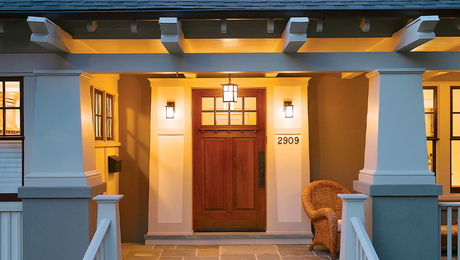*
I’ve heard that the best thing to do with stone foundations is to leave them alone, but that doesn’t seem like good advice when the foundation is over 30% of the total heat loss (and drafty). Should they be insulated on the outside? What about 2″ Type II EPS on the inside, in a pressure-treated stud wall, the white foam breathes a little… any thoughts on pressure treated wood inside a building? This is a damp basement, drywall would mold, what would the EPS be covered with? I’ve seen stone basements urethane-foamed inside then covered in spray-on fire-retardent cellulose. Doesn’t this violate every rule about insulating stone basements? What’s the “right” way to insulate an old stone foundation? Thanks!
Discussion Forum
Discussion Forum
Up Next
Video Shorts
Featured Story

Lighting up an exterior isn't just about ambiance— it's also about code compliance. Here is what the code says about safety and efficiency when it comes to outdoor lighting.
Featured Video
How to Install Cable Rail Around Wood-Post CornersHighlights
Fine Homebuilding Magazine
- Home Group
- Antique Trader
- Arts & Crafts Homes
- Bank Note Reporter
- Cabin Life
- Cuisine at Home
- Fine Gardening
- Fine Woodworking
- Green Building Advisor
- Garden Gate
- Horticulture
- Keep Craft Alive
- Log Home Living
- Military Trader/Vehicles
- Numismatic News
- Numismaster
- Old Cars Weekly
- Old House Journal
- Period Homes
- Popular Woodworking
- Script
- ShopNotes
- Sports Collectors Digest
- Threads
- Timber Home Living
- Traditional Building
- Woodsmith
- World Coin News
- Writer's Digest


















Replies
*
Hi Ross,
Better on the outside.
If its a stone house, asthetically speaking, you should still excavate the outside perimeter, repoint, apply several coats of waterproofing, install sm up the the ground level.
Drying up the foundations perimeter will go a long way to make the installation of any interior insulation or finishes much easier. (and effective)
Gabe
*Well foundation insulation can go either outside or inside. It seems the general custom is that new foundations are insulated on the outside while remodels are on the inside. From an energy point of view I doubt there is enough difference to justify the cost of excavation unless you already need to for drainage purposes.As far as inside foam is concerned there is a spray on cementous fire coating that I have used. Not familiar with the cellulose product you mention.
*RossYou should get a hold of the CMHC paper i "Basement Walls that Dry" March /99. It provides test stats on a variety of interior basement insulating systems. Alsoi "In Situ Performance of Expanded Molded Polystyrene in the Exterior Basement Insulation Systems" National Research Council, Ottawa (e-mail [email protected])Neither address i stone wallsbut the info will help with the decision.-pm
*Ross - there is a large contingent of people that preferr to let sleeping dogs lie with respect to the cobblestone basements. They have several valid reasons for not wanting to disturb the backfill around these walls. There are also cases where it is impossible to excavate around the perimeter of a building to work on the outside.In these situations it is perfectly acceptable to retrofit a poly vapor barrier on the inside and then use expanded polystyrene or batt insulation. It comes at what some consider to be a price in durability because now the wall will be wetter and colder.I tend to question where you were got the 30% heat loss number.-Rob